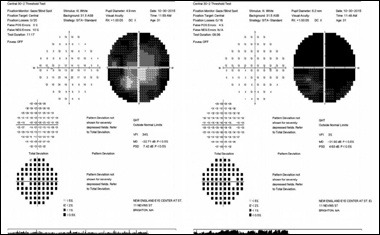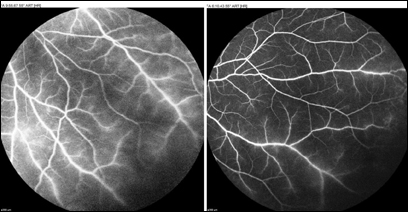Man presents with history of headaches, sudden vision decline
The patient was previously diagnosed with a dural venous sinus thrombosis.
A 31-year-old man presented from an outside hospital with a 3-month history of headaches and 6 days of blurry vision in both eyes. He was previously found to have a dural venous sinus thrombosis on CT and MRI. He described the decline in vision to be “fairly sudden” and “a black cloud” in the center of his vision, greater in the right eye than the left eye. He was transferred to our hospital for complete work-up of his dural venous sinus thrombosis and acute decline in vision.
His ocular history was unremarkable. His medical history was significant for an unprovoked deep venous thrombosis 3 years prior, as well as multiple episodes of oral and genital ulcers. He had not had any prior surgeries, and his family history was unremarkable. He was born in the Dominican Republic. He denied tobacco, alcohol or illicit drug use as well as risk-taking sexual activity. He denied any known drug allergies.
Examination
The patient’s near visual acuity was counting fingers at 6 feet in the right eye and 20/20-2 in the left eye. The right pupil showed a relative afferent pupillary defect. IOPs were normal at 10 mm Hg and 11 mm Hg in the right and left eyes, respectively. He was able to identify only 1 out of 10 Ishihara color plates in the right eye compared with 10 out of 10 in the left eye. His extraocular muscles were full.
30-2 Humphrey visual fields showed global depression in both eyes but greater in the right eye (Figure 1). Anterior segment slit lamp exam revealed trace conjunctival injection, fine keratic precipitates, 2+ anterior chamber cell and few pigmented cells on the anterior capsule in the right eye. In the left eye, there was trace anterior chamber cell, but the conjunctiva and cornea were clear.
Dilated funduscopy of the right eye showed 2+ vitreous cell, diffuse papillitis with whitening along the rim, few small peripapillary hemorrhages, peripapillary retinal elevation with hazy-appearing whitening, pre-retinal fluffy consolidation over the inferior nerve rim, macular striae, perivascular sheathing, numerous small mid-peripheral hemorrhages and few peripheral dot hemorrhages (Figure 2). Dilated funduscopy of the left eye showed 1+ vitreous cell, diffuse papillitis with trace whitening along the rim, few small peripapillary hemorrhages, peripapillary retinal elevation with trace amount of whitening and few areas of perivascular sheathing (Figure 3). There was no peripheral retinal whitening in either eye.

Images: Rifkin L, Vuong LN and Wright E




The findings on our patient’s funduscopy exam prompted us to perform a more extensive review of systems. As noted previously, he had a history of recurrent oral and genital ulcers diagnosed as herpes, although he stated that they never seemed to improve with the acyclovir that his physician had prescribed. Furthermore, he disclosed that he had oral and genital ulcers at the present time. On exam, his genital ulcer was sharply demarcated with an erythematous base. He denied any fevers, chills, night sweats or unintentional weight loss. He denied any recent travel, chronic cough or trouble breathing, or new rashes or skin changes.
OCT of the macula of the right eye showed a mildly exudative subfoveal detachment with a shaggy appearance to the photoreceptor layer in the area of the detachment. Both eyes had mild inner retinal thickening on OCT (Figure 4). Fluorescein angiography highlighted areas of late vessel leakage in both eyes, signifying active retinal vasculitis (Figure 5).
What is your diagnosis?
Papillitis, panuveitis, retinal vasculitis
The differential diagnosis of bilateral papillitis, panuveitis and retinal vasculitis includes autoimmune/inflammatory, infectious and malignant etiologies. Possible autoimmune or inflammatory etiologies include Behçet’s disease, sarcoidosis, systemic lupus erythematosus, granulomatosis with polyangiitis (Wegener’s) and polyarteritis nodosa. Possible infectious etiologies include tuberculosis, syphilis, HIV, other viruses (HSV, EBV, CMV, VZV), endogenous endophthalmitis (bacterial, fungal) and Lyme disease. Malignancy must always be kept in mind, including metastases, lymphoma and leukemia.
Diagnosis and treatment
Our patient was admitted to the hospital, and a work-up was initiated. CBC showed mild leukopenia and mildly decreased hemoglobin and hematocrit, but platelets were normal. A basic metabolic panel and ACE were both normal. HIV, anti-phospholipid antibodies, anti-cardiolipin IgG antibodies, anti-beta 2 microglobulin, ANA, RPR, FTA-antibodies, HSV-1 and HSV-2 PCR, HLA-B51 and HLA-B5701 were all negative. Anti-cardiolipin IgM antibodies were mildly elevated, which was a relatively non-specific finding. QuantiFERON Gold testing was positive, and his chest X-ray was unremarkable.
As mentioned previously, an MRI at an outside hospital showed a thrombosis within the straight sinus and bilateral transverse sinuses without any bleeding or mass effect. A dedicated MRI of the orbits was unremarkable, demonstrating no enhancement or compression of the optic nerves bilaterally. A lumbar puncture was performed with an elevated opening pressure of 34 mm Hg. The appearance of the cerebrospinal fluid (CSF) was clear. Gram stain of the CSF had 3+ PMNs and 3+ other white blood cells, but no organisms were seen. There were 16 nucleated cells in the CSF (high; normal range, 0 to 5), with 79% lymphocytes (normal) and 21% monocytes/macrophages (normal). Culture of the CSF showed no growth, and there were no oligoclonal bands.
To control ocular inflammation, the patient was given 1 g of IV Solu-Medrol (methylprednisolone sodium succinate, Pfizer) daily for 3 days and then transitioned to oral prednisone. He was also started on Pred Forte topical corticosteroids (prednisolone acetate ophthalmic suspension, Allergan) at one drop six times daily in both eyes. Given his elevated opening pressure on the lumbar puncture, we also started Diamox (acetazolamide) 500 mg by mouth three times a day. In consultation with the infectious disease team, he was started on isoniazid and vitamin B6 as well as Bactrim (sulfamethoxazole and trimethoprim) for PCP prophylaxis for latent tuberculosis. Lastly, given that our patient’s constellation of clinical findings including dural venous sinus thrombosis, oral and genital ulcers, and bilateral papillitis, panuveitis and active retinal vasculitis, he was diagnosed with Behçet’s disease. Accordingly, rheumatology was consulted with regard to starting immunomodulatory therapy. Although TNF-alpha inhibitors such as Remicade (infliximab, Janssen) or Humira (adalimumab, AbbVie) are often first-line therapy for Behçet’s disease, these are contraindicated in the setting of latent tuberculosis. He was ultimately started on Imuran (azathioprine) 50 mg by mouth daily (1 mg/kg), which was to be slowly titrated up to 2.5 mg/kg/day.
Our patient demonstrated steady and promising improvement on the above therapy, and within 3 months his right eye visual acuity had improved from counting fingers to 20/30. His funduscopic exams showed dramatic improvement in disc edema and retinal vasculitis in both eyes.
Discussion
The entity of Behçet’s disease is characterized by chronic relapsing obliterative vasculitis of both arteries and veins of all calibers. Classic features include recurrent oral and genital ulcers, uveitis and skin lesions (erythema nodosum, papulopustular lesions, acneiform nodules). Recurrent oral ulcers are the presenting feature in 66% to 76% of patients, and the disease typically presents in the second or third decade of life.
Diagnosis of the disease is predominantly clinical as there are no specific lab tests or pathognomonic findings. Pathergy testing has been shown to have highly variable sensitivity (40% to 98%), but it is highly specific. HLA-B51 is the most closely associated genetic factor and marker of disease severity; however, its presence or absence is not enough to rule in or rule out the disease. For patients with HLA-B51 positivity, the odds ratio of disease development ranges from 1.5 to 20 in different series. This high variability is attributed to the haplotype having varying levels of disease predictability in different ethnicities.
Ocular Behçet’s develops in more than 50% of patients with the disease. Typically, the development of ocular involvement follows the onset of oral and genital ulcers by a few years. It is almost always bilateral but may be asymmetric; it is more common and more severe in males. Most commonly, it will present as a recurrent, non-granulomatous intraocular inflammation: anterior, intermediate, posterior or panuveitis. The classic teaching is to look for a shifting hypopyon, although one review study found this to be present in only 12% of 1,567 eyes.
The incidence of posterior segment involvement in ocular Behçet’s is 50% to 93%, with vitritis and retinal vasculitis being the most common findings (89%). Other reported posterior findings include cystoid macular edema, retinal hemorrhage, retinal neovascularization, chorioretinitis, exudative or tractional retinal detachment, optic nerve edema, central retinal vein occlusion and branch retinal vein occlusion. Reported anterior findings include scleritis, episcleritis, recurrent conjunctivitis, conjunctival ulcers and filamentary keratitis.
Treatment of ocular Behçet’s disease may include, in order of increasing severity, topical corticosteroid and cycloplegic drops, sub-Tenon’s or intravitreal triamcinolone, systemic steroids and, lastly, immunosuppressive/immunomodulatory therapy. Azathioprine was the first immunomodulatory drug shown in a randomized controlled clinical trial to have efficacy in treatment of Behçet’s disease (Yazici and colleagues, 1990). It has also been shown to be effective in preventing development of new eye disease in patients with Behçet’s who do not already have eye involvement. Other frequently used immunomodulatory therapies include cyclosporine and methotrexate. More recently, following studies showing increased serum and aqueous levels of TNF-alpha in Behçet’s patients, TNF inhibitors infliximab and adalimumab have also been used with success in the treatment of Behçet’s disease.
- References:
- Atmaca-Sonmez P. Expert Rev Ophthalmol. 2007;doi:10.1586/17469899.2.6.957.
- Behçet H. Dermatologische Wochenschrift. 1937;105:1152-1157.
- Davatchi F, et al. Int J Rheum Dis. 2014;doi:10.1111/1756-185X.12248.
- Hamuryudan V, et al. Arthritis Rheum. 1997;doi:10.1002/art.1780400425.
- Joussen AM, Gardner TW, Kirchhof B, Ryan SJ. Retinal Vascular Disease. Berlin, Germany: Springer; 2007:635-645.
- Kaya TI. Patholog Res Int. 2012;doi:10.1155/2012/912589.
- Markomichelakis N, et al. Rheumatology (Oxford). 2011;doi:10.1093/rheumatology/keq366.
- Markomichelakis N, et al. Am J Ophthalmol. 2012;doi:10.1016/j.ajo.2012.03.035.
- Nussenblatt RB, Whitcup SM. Uveitis: Fundamentals and Clinical Practice. 4th ed. 2010;332-354.
- Ozyazgan Y, et al. Clinic Rev Allerg Immunol. 2015;doi:10.1007/s12016-014-8425-z.
- Tabbara KF, et al. Am J Ophthalmol. 2008;doi:10.1016/j.ajo.2008.09.010.
- Yazici H, et al. N Engl J Med. 1990;doi:10.1056/NEJM199002013220501.
- For more information:
- Lana Rifkin, MD, Laurel N. Vuong, MD, and Emily Wright, MD, can be reached at New England Eye Center, Tufts University School of Medicine, 750 Washington St., Box 450, Boston, MA 02111; website: www.neec.com.
- Edited by Kristen E. Dunbar, MD, and Kendra Klein, MD. They can be reached at New England Eye Center, Tufts University School of Medicine, 750 Washington St., Box 450, Boston MA 02111; website: www.neec.com.
